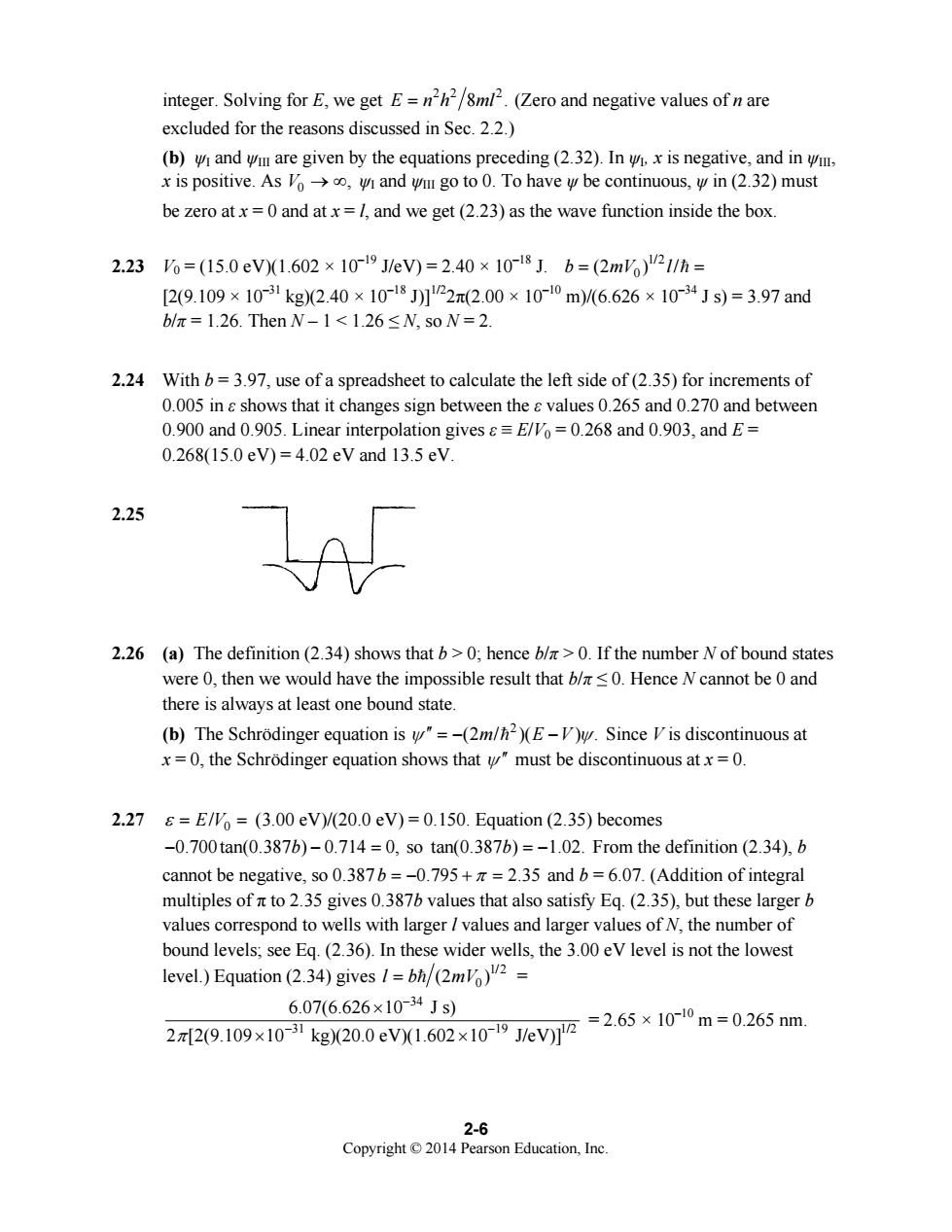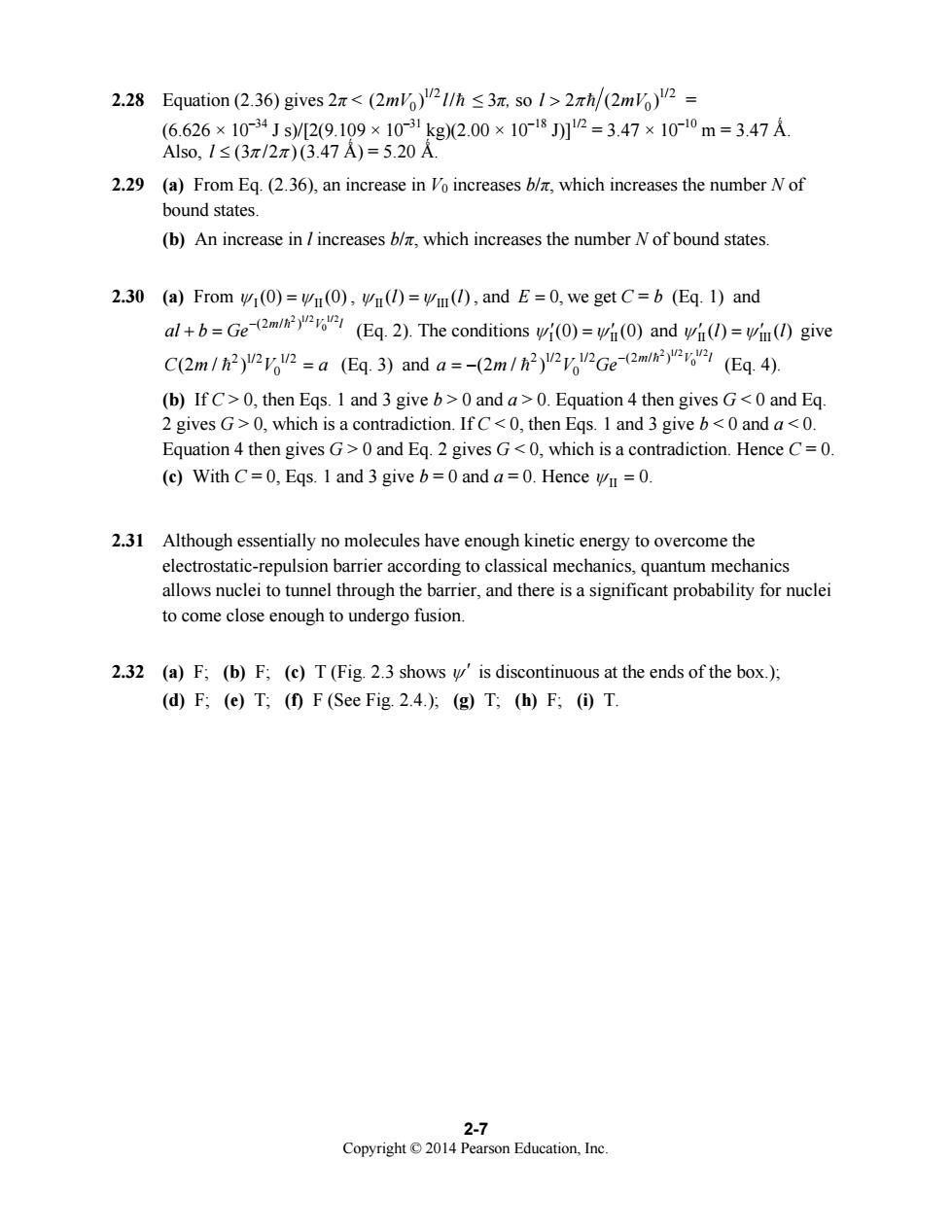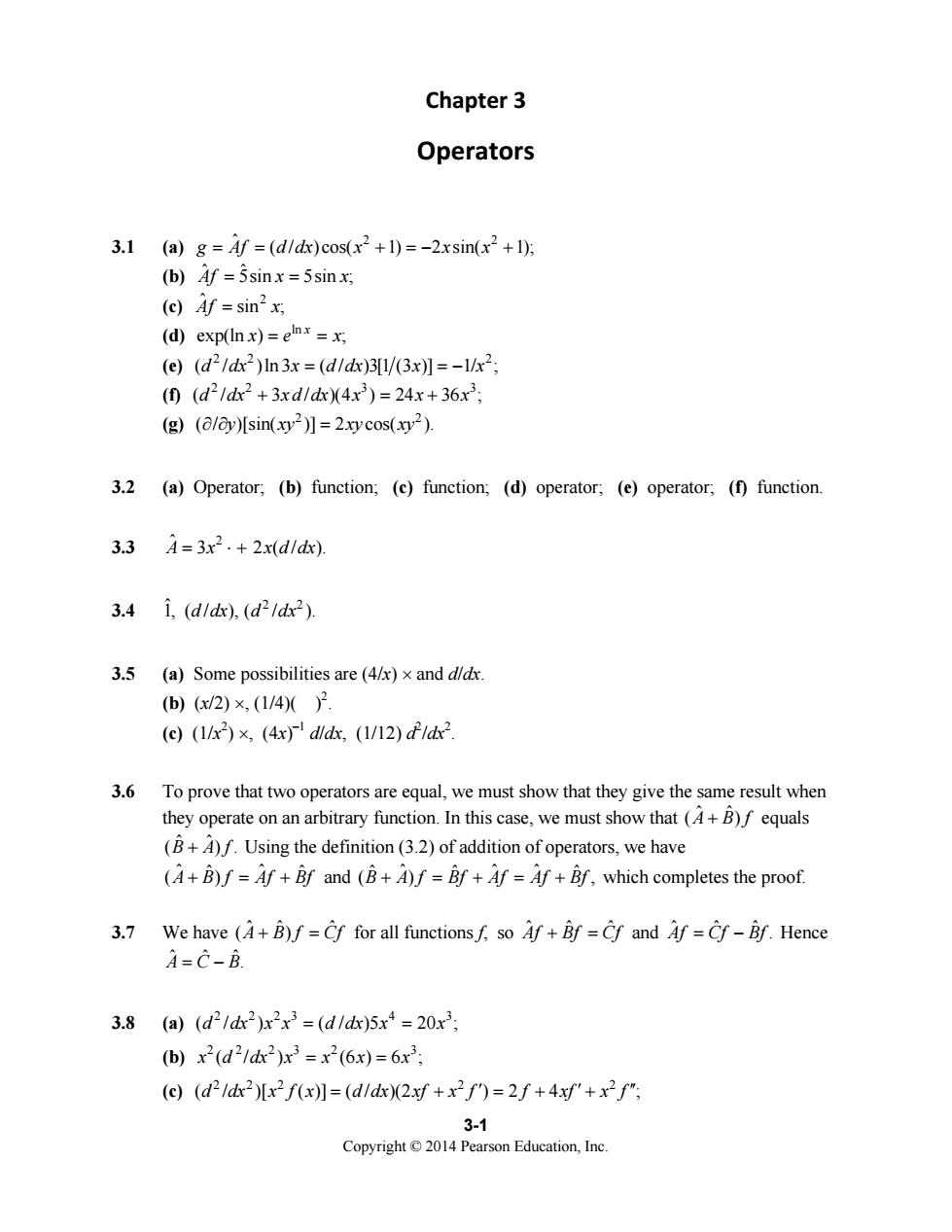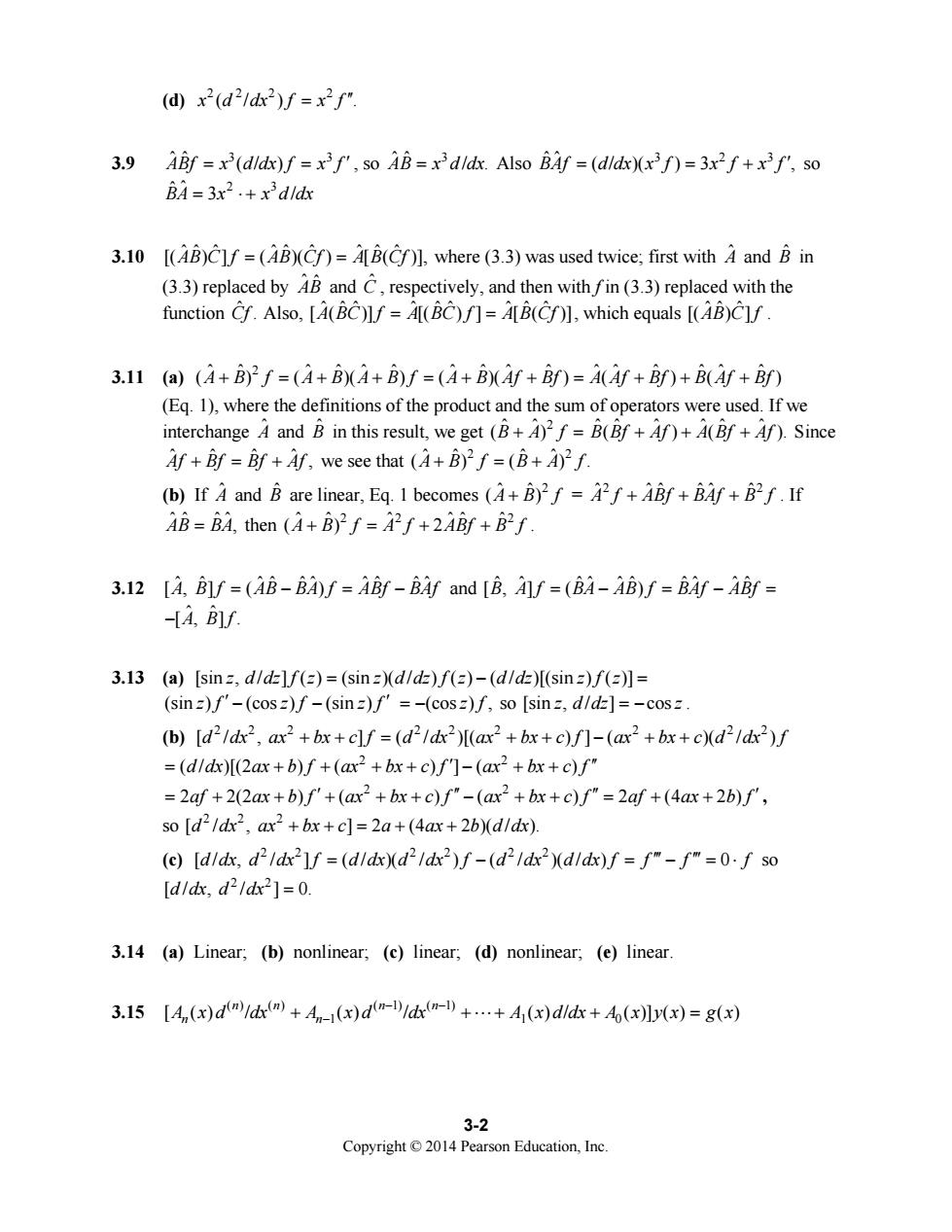
integer.Solving for E,we get E=nh/8m.(Zero and negative values ofn are excluded for the reasons discussed in Sec.2.2.) (b)and are given by the equations preceding(2.32).Inxis negative,and in ispositive.havebe continuous,in(32)must be zero atx=0 and atx=I,and we get(2.23)as the wave function inside the box. 2.23%=(15.0eV(1.602×1019JeV)=2.40×1018J.b=(2m)21/h [2(9.109×1031kg2.40×10-18J]22π(2.00×1010m)6.626×1034Js)=3.97and b/1.26.Then N-1 1.26 N,so N=2. 2.24 With b=3.97,use of a spreadsheet to calculate the left side of (2.35)for increments of 0.005 in e shows that it changes sign between the values 0.265 and 0.270 and between 0.900 and 0.905.Linear interpolation gives e=E/Vo=0.268 and 0.903,and E= 0.268(15.0eV=4.02 eV and13.5eV 2.25 2.26 (a)The definition(2.34)shows that b>0;hence b/>0.If the number N of bound states were 0.then we would have the impossible result that b/<0.Hence N cannot be 0 and there is always at least one bound state. (b)The Schrodinger equation is"=-(2m/h2)(E-V).Since V is discontinuous at x=0,the Schrodinger equation shows that y"must be discontinuous atx=0. 2.27 =E/Vo=(3.00 eV)/(20.0 eV)=0.150.Equation (2.35)becomes -0.700tan(0.387b)-0.714=0,so tan(0.387b)=-1.02.From the definition(2.34),b cannot be negative,so 0.3876=-0.795+=2.35 and b=6.07.(Addition of integral multiples of to 2.35 gives 0.387b values that also satisfy Eq.(2.35),but these larger b values correspond to wells with larger values and larger values of N,the number of bound levels;see Eq.(2.36).In these wider wells,the 3.00 eV level is not the lowest level.)Equation(2.34)gives I=bh/(2mV)2= 6.07(6.626×1034Js) 2m29.109x10kgX20.0eV1602x10-9/y=2.65×100m=0265nm 26 Copyright2014 Pearson Education.Inc
Copyright © 2014 Pearson Education, Inc. 2-6 integer. Solving for E, we get 22 2 E n h ml = 8 . (Zero and negative values of n are excluded for the reasons discussed in Sec. 2.2.) (b) ψI and ψIII are given by the equations preceding (2.32). In ψI, x is negative, and in ψIII, x is positive. As 0 V → ∞, ψI and ψIII go to 0. To have ψ be continuous, ψ in (2.32) must be zero at x = 0 and at x = l, and we get (2.23) as the wave function inside the box. 2.23 V0 = (15.0 eV)(1.602 × 10–19 J/eV) = 2.40 × 10–18 J. 1/2 0 b mV l = (2 ) /= = [2(9.109 × 10–31 kg)(2.40 × 10–18 J)]1/22π(2.00 × 10–10 m)/(6.626 × 10–34 J s) = 3.97 and b/π = 1.26. Then N – 1 < 1.26 ≤ N, so N = 2. 2.24 With b = 3.97, use of a spreadsheet to calculate the left side of (2.35) for increments of 0.005 in ε shows that it changes sign between the ε values 0.265 and 0.270 and between 0.900 and 0.905. Linear interpolation gives ε ≡ E/V0 = 0.268 and 0.903, and E = 0.268(15.0 eV) = 4.02 eV and 13.5 eV. 2.25 2.26 (a) The definition (2.34) shows that b > 0; hence b/π > 0. If the number N of bound states were 0, then we would have the impossible result that b/π ≤ 0. Hence N cannot be 0 and there is always at least one bound state. (b) The Schrödinger equation is 2 ψ′′ =− − (2 / )( ) . m EV = ψ Since V is discontinuous at x = 0, the Schrödinger equation shows that ψ′′ must be discontinuous at x = 0. 2.27 0 ε = = E V/ (3.00 eV)/(20.0 eV) = 0.150. Equation (2.35) becomes − −= 0.700 tan(0.387 ) 0.714 0, b so tan(0.387 ) 1.02. b = − From the definition (2.34), b cannot be negative, so 0.387b = − += 0.795 2.35 π and b = 6.07. (Addition of integral multiples of π to 2.35 gives 0.387b values that also satisfy Eq. (2.35), but these larger b values correspond to wells with larger l values and larger values of N, the number of bound levels; see Eq. (2.36). In these wider wells, the 3.00 eV level is not the lowest level.) Equation (2.34) gives 1/2 0 l b mV = = (2 ) = 34 31 19 1/2 6.07(6.626 10 J s) 2 [2(9.109 10 kg)(20.0 eV)(1.602 10 J/eV)] π − − − × × × = 2.65 × 10–10 m = 0.265 nm

2.28 Equation(2.36)gives2π<(2m'o)21/h≤3z,so1>2πh/(2m%)= (6.626×10-4Js/[2(9.109×1031kg2.00×1018J)月2=3.47×1010m=3.47A A1s0,1≤(3π/2π)3.47A)=5.20A 2.29 (a)From Eq.(2.36),an increase in Vo increasesb/z,which increases the number Nof bound states. (b)An increase in increases b/z,which increases the number N of bound states. 2.30 (a)().()=m(),and E=0.we get C=b(Eq.1)and al+b=Ge (Eq.).The conditions=)and give C(m2=a (Eq.3)and a=-(2mGe(Eq 4). (b)If C>0,then Eqs.1 and 3 give b>0 and a>0.Equation 4 then gives G<0 and Eq. 2 givesG,which is a contradiction.IfC<,then Eqs.I and 3 give b<anda< Equation 4 then gives G>0and Eq.2 gives G<0,which is a contradiction.Hence C=0. (c)With C=0,Eqs.I and 3 give b=0 and a=0.Hence wn =0. 2.31 Although essentially no molecules have enough kinetic energy to overcome the electrostatic-repulsion barrier according to classical mechanics,quantum mechanics allows nuclei to tunnel through the barrier,and there is a significant probability for nuclei to come close enough to undergo fusion. 2.32 (a)F:(b)F;(c)T(Fig.2.3 shows y'is discontinuous at the ends of the box.); (d)F;(e)T;(f)F(See Fig.2.4.);(g)T:(h)F:(i)T. 2-7 Education.Inc
Copyright © 2014 Pearson Education, Inc. 2-7 2.28 Equation (2.36) gives 2π < 1/2 0 (2 ) / mV l = ≤ 3π, so 1/2 0 l mV > 2 (2 ) π = = (6.626 × 10–34 J s)/[2(9.109 × 10–31 kg)(2.00 × 10–18 J)]1/2 = 3.47 × 10–10 m = 3.47 Ǻ. Also, (3 /2 ) l ≤ π π (3.47 Ǻ) = 5.20 Ǻ. 2.29 (a) From Eq. (2.36), an increase in V0 increases b/π, which increases the number N of bound states. (b) An increase in l increases b/π, which increases the number N of bound states. 2.30 (a) From I II ψ (0) (0) =ψ , II III ψ () () l l =ψ , and 0, E = we get C = b (Eq. 1) and 2 1/2 1/2 0 (2 / ) m Vl al b Ge− + = = (Eq. 2). The conditions I II ψ′(0) (0) =ψ′ and II III ψ′ ′ () () l l =ψ give 2 1/2 1/2 0 Cm V a (2 / ) = = (Eq. 3) and 2 1/2 1/2 0 2 1/2 1/2 (2 / ) 0 (2 / ) m Vl a m V Ge− = − = = (Eq. 4). (b) If C > 0, then Eqs. 1 and 3 give b > 0 and a > 0. Equation 4 then gives G < 0 and Eq. 2 gives G > 0, which is a contradiction. If C < 0, then Eqs. 1 and 3 give b < 0 and a < 0. Equation 4 then gives G > 0 and Eq. 2 gives G < 0, which is a contradiction. Hence C = 0. (c) With C = 0, Eqs. 1 and 3 give b = 0 and a = 0. Hence II ψ = 0. 2.31 Although essentially no molecules have enough kinetic energy to overcome the electrostatic-repulsion barrier according to classical mechanics, quantum mechanics allows nuclei to tunnel through the barrier, and there is a significant probability for nuclei to come close enough to undergo fusion. 2.32 (a) F; (b) F; (c) T (Fig. 2.3 shows ψ′ is discontinuous at the ends of the box.); (d) F; (e) T; (f) F (See Fig. 2.4.); (g) T; (h) F; (i) T

Chapter 3 Operators 3.1 (a)g=4f (d/dx)cos(x2+1)=-2xsin(x2+1); (b)4f=5sinx=5sinx, (c)4f=sin2x. (d)exp(Inx)=elnx=x. (e)(d2/d2)n3x=(d/d)3/3x】=-1/x2 (0(d21d2+3xd/X4x)=24x+36x2 (g)(a/@)[sin(x3y2】=2ycos(32). 3.2 (a)Operator,(b)function;(c)function,(d)operator;(e)operator,(f)function. 3.3A=3x2.+2x(d/dr) 3.41,(d/d,(d21dr2) 3.5 (a)Some possibilities are(4/x)x and d/d (b)(x/2)×(1/4)()2. (c(1x3x,(4x)ddk,(1/12)12 3.6 To prove that two operators are equal,we must show that they give the same result when they operate on an arbitrary function.In this case,we must show that(+B)fequals (B+f.Using the definition (3.2)of addition of operators,we have (A+B)f=Af+Bf and (B+)f=Bf+if=4f+Bf,which completes the proof. 3.7 We have(a+B)f=可for all functionsf.so+f=C可and=可-f.Hence A=C-B 3.8(a)(d2/d2)x2x3=(d1d)5x4=20x3 (b)x2(d21dk2)x3=x2(6x)=6x3: (c)(d2ldx2)x2f(x)]=(dldx)(2xf+xf)=2f+4xf+x2f". 3-1 Copyright2014 Pearson Education,Inc
Copyright © 2014 Pearson Education, Inc. 3-1 Chapter 3 Operators 3.1 (a) ˆ 2 2 g Af d dx x x x = = + =− + ( / )cos( 1) 2 sin( 1); (b) ˆ ˆ Af xx = = 5sin 5sin ; (c) ˆ 2 Af x = sin ; (d) ln exp(ln ) ; x x = = e x (e) 22 2 ( / )ln 3 ( / )3[1 (3 )] 1/ ; d dx x d dx x x = =− (f) 22 3 3 ( / 3 / )(4 ) 24 36 ; d dx x d dx x x x + =+ (g) 2 2 ( / )[sin( )] 2 cos( ). ∂∂ = y xy xy xy 3.2 (a) Operator; (b) function; (c) function; (d) operator; (e) operator; (f) function. 3.3 ˆ 2 A = ⋅+ 3 2 ( / ). x x d dx 3.4 ˆ 2 2 1, ( / ), ( / ). d dx d dx 3.5 (a) Some possibilities are (4/x) × and d/dx. (b) (x/2) ×, (1/4)( )2 . (c) (1/x 2 ) ×, (4x) –1 d/dx, (1/12) d2 /dx2 . 3.6 To prove that two operators are equal, we must show that they give the same result when they operate on an arbitrary function. In this case, we must show that ˆ ˆ ( ) A + B f equals ˆ ˆ ( ). B + A f Using the definition (3.2) of addition of operators, we have ˆ ˆ ˆ ˆ ( ) A B f Af Bf + =+ and ˆˆ ˆ ˆ ˆˆ () , B + =+=+ A f Bf Af Af Bf which completes the proof. 3.7 We have ˆ ˆ ˆ ( ) A + = B f Cf for all functions f, so Aˆ ˆ ˆ f Bf Cf + = and ˆ ˆ ˆ Af Cf Bf = − . Hence ˆ ˆ ˆ A = − C B. 3.8 (a) 2 2 23 4 3 ( / ) ( / )5 20 ; d dx x x d dx x x = = (b) 2 2 23 2 3 x ( / ) (6 ) 6 ; d dx x x x x = = (c) 222 2 2 ( / )[ ( )] ( / )(2 ) 2 4 ; d dx x f x d dx xf x f f xf x f = + =+ + ′ ′ ′′

(d)x2(d2ldx2)f=x2f" 3.9 ABf=x (dldx)f=xf',so AB=xdldx.Also BAf =(dldx(xf=3x2f+xf'so BA=3x2.+xdldx 3.10 [(B)clf=(AB)(Cf)=B(Cf)],where (3.3)was used twice;first with A and B in (3.3)replaced byB and C.respectively,and then with /in(3.3)replaced with the function Cf.Also,[A(BC)If=A[(BC)f]=A[B(C)],which equals [(AB)C]f. 3.11 (a)(+B)2f=(4+BX(4+B)f=(4+BXAf+Bf)=A(f+Bf)+B(Af+Bf) (Eq.1),where the definitions of the product and the sum of operators were used.If we interchange and B in this result,we get (B+)2f=B(Bf+Af)+(Bf+4f).Since Af+Bf=Bf+if,we see that (A+B)2f=(B+A)2f. (b)If A and B are linear,Eq.1 becomes (+B)2f=f+Bf+Bf+B2f.If AB=BA,then (4+B)2f=2f+Bf+B2f. 3.12 14.Bl=(AB-BA)f=ABf-BAf and [B.Alf =(BA-AB)f=BAf-ABf= -[A,B]f. 3.13 (a)[sin=,dld=]f(=)=(sin=(dld)f(=)-(d/d)[(sin=)f(=]= (sin=)f"-(cos=)f-(sin=)f'=-(cos=)f,so [sin=,d/d=]=-cos=. (b)[d2/dx2,ax2+bx+clf=(d2/dx2)(ax2+bx+c)]-(ax2+bx+c)d2ldx2)f =(d/dx)[(2ax+b)f+(ax2+bx+c)f]-(ax2+bx+c)f" 2af +2(2ax+b)f'+(ax2+bx+c)f"-(ax2+bx+c)f"=2af +(4ax+2b)f', so [d2 /dx2,ax2+bx+c]=2a+(4ax+2b)(d/dx). (e)Idldx,d2ldx2f=(dldxd2ldx2)f-(d2ldx2n(dldx)f =f"-f"=0.f so [d/dk,d21d2]=0. 3.14 (a)Linear;(b)nonlinear;(c)linear,(d)nonlinear,(e)linear. 3.15 [A(x)d(m)x()+A(x)d(-x++A(x)dlx+(x)y(x)=g(x) 3-2 Copyright2014 Pearson Education,Ine
Copyright © 2014 Pearson Education, Inc. 3-2 (d) 22 2 2 x (/ ) . d dx f x f = ′′ 3.9 ˆ 3 3 ˆ ABf x d dx f x f = = (/ ) ′ , so ˆ 3 ˆ AB x d dx = / . Also ˆ 3 23 ˆ BAf d dx x f x f x f = =+ ( / )( ) 3 ,′ so ˆ 2 3 ˆ BA x x d dx = ⋅+ 3 / 3.10 ˆˆ ˆ ˆ ˆ ˆ ˆˆˆ [( ) ] ( )( ) [ ( )], AB C f AB Cf A B Cf = = where (3.3) was used twice; first with Aˆ and Bˆ in (3.3) replaced by ABˆ ˆ and Cˆ , respectively, and then with f in (3.3) replaced with the function ˆCf . Also, ˆˆ ˆ ˆ ˆ ˆ ˆ ˆˆ [ ( )] [( ) ] [ ( )] A BC f A BC f A B Cf = = , which equals ˆ ˆ ˆ [( ) ] AB C f . 3.11 (a) ˆ ˆ ˆ ˆ ˆ ˆˆ ˆ 2 ˆ ˆ ˆ ˆ ˆ ˆˆ ˆ ( ) ( )( ) ( )( ) ( ) ( ) A + =+ + =+ + = + + + B f A B A B f A B Af Bf A Af Bf B Af Bf (Eq. 1), where the definitions of the product and the sum of operators were used. If we interchange Aˆ and Bˆ in this result, we get ˆ 2 ˆ ( ) B + A f = ˆˆ ˆ ˆˆ ˆ B( ) ( ). Bf Af A Bf Af ++ + Since ˆ ˆ ˆ ˆ Af Bf Bf Af +=+ , we see that ˆ ˆ 2 2 ˆ ˆ ( ) ( ). A + =+ Bf BAf (b) If Aˆ and Bˆ are linear, Eq. 1 becomes ˆ 2 ˆ ( ) A + B f = ˆˆ ˆ 2 2 A ˆˆ ˆ f ABf BAf B f +++ . If ˆ ˆ ˆ ˆ AB BA = , then ˆ ˆˆ 22 2 ˆ ˆˆ () 2 A B f A f ABf B f + =+ + . 3.12 ˆ ˆˆˆ ˆ ˆ ˆˆ ˆ ˆ [, ] ( ) A B f AB BA f ABf BAf =− = − and ˆ ˆˆˆ ˆ ˆ ˆˆ ˆ ˆ [, ] ( ) B A f BA AB f BAf ABf = − =−= ˆ ˆ −[, ]. ABf 3.13 (a) [sin , / ] ( ) (sin )( / ) ( ) ( / )[(sin ) ( )] z d dz f z z d dz f z d dz z f z =− = (sin ) (cos ) (sin ) zf zf zf ′ ′ − − = −(cos ) , z f so [sin , / ] cos z d dz z = − . (b) 22 2 22 2 2 22 [ / , ] ( / )[( ) ] ( )( / ) d dx ax bx c f d dx ax bx c f ax bx c d dx f ++ = ++ − ++ 2 2 = + + ++ − ++ ( / )[(2 ) ( ) ] ( ) d dx ax b f ax bx c f ax bx c f ′ ′′ 2 2 = + + + ++ − ++ = + + 2 2(2 ) ( ) ( ) 2 (4 2 ) af ax b f ax bx c f ax bx c f af ax b f ′ ′′ ′′ ′ , so 22 2 [ / , ] 2 (4 2 )( / ). d dx ax bx c a ax b d dx + += + + (c) 22 22 22 [ / , / ] ( / )( / ) ( / )( / ) 0 d dx d dx f d dx d dx f d dx d dx f f f f = − = − =⋅ ′′′ ′′′ so 2 2 [ / , / ] 0. d dx d dx = 3.14 (a) Linear; (b) nonlinear; (c) linear; (d) nonlinear; (e) linear. 3.15 ( ) ( ) ( 1) ( 1) 1 10 [ ( ) / ( ) / ( ) / ( )] ( ) ( ) nn n n An n x d dx A x d dx A x d dx A x y x g x − − + ++ + = −

3.16 Given:A(f+g)=Af+Ag.A(cf)=cAf,B(f+g)=Bf+Bg,B(cf )c(Bf). Prove:AB(f+g)=aBf+ABg,AB(cf)=cABf. Use of the given equations givesg)=)) ABf+ABg,since Bf and Bg are functions;also.B(cf)=A(cBf)=cB)=cBf. 3.17 We have (B+C)f=(B+Cf)(defn.of sum of ops.B and C) =(Bf)+(C)(linearity of ABf+ACf (defn.of op.prod.) =(B+C)f (defn.of sum of ops.AB and AC) Hence (B+C)=B+C. 3.18 (a)Using first (3.9)and then (3.10),we have A(bf+cg)=A(bf)+A(cg)=bAf+c4g. (b)Setting b=I and c=1 in (3.94),we get (3.9).Setting c=0 in (3.94),we get (3.10). 3.19 (a)Complex conjugation,since (f+g)*=f*+g*but (cf )*=cf*cf*. b)()'(dld()',since()'(dd()'gf=()'(d)cf1= ()[c()f]=-cf2/f'and d )'(dldx)()f=d (didx)= -c()2f)=-cf2/f',but ()'(dd('f+g)=()'(ddf+g)=()'[U+g)2(f'+g)]= (f+g}2(f'+g)+()(dd)f+('(dd()g=-f1f'-g21g' 3.20 (a)This is always true since it is the definition of the sum of operators. (b)Only true if is linear (c)Not generally true;for example,it is false for differentiation and integration.It is true if 4 is multiplication by a function. (d)Not generally true.Only true if the operators commute. (e)Not generally true. (Not generally true. (g)True,since f=gf. (h)True,since Bg is a function 3.21 (a)ThLf(x)+g(x)]=f(x+h)+g(x+h)=Thf(x)+Tig(x) Also,flef(x)]=cf(x+h)=cf(x).So i is linear 3-3 Copyright2014 Pearson Education,Inc
Copyright © 2014 Pearson Education, Inc. 3-3 3.16 Given: ˆ ˆ ˆˆ ˆ ˆ ˆ ˆˆ ˆ A f g Af Ag A cf cAf B f g Bf Bg B cf c Bf ( ) , ( ) , ( ) , ( ) ( ). += + = += + = Prove: ˆ ˆ ˆˆ ˆ ˆ ˆ ˆˆ ˆ AB f g ABf ABg AB cf cABf ( ) , () . += + = Use of the given equations gives ˆ ˆ ˆˆ ˆ ˆˆ ˆ ˆ AB f g A Bf Bg A Bf A Bg ( ) ( ) () () + = += + = ˆ ˆ ˆ ˆ ABf ABg + , since Bˆf and Bˆg are functions; also, ˆˆ ˆˆ ˆ ˆ ˆˆ AB cf A cBf cA Bf cABf () ( ) ( ) . === 3.17 We have ˆˆ ˆ ˆ ˆ ˆˆ ˆ ( ) ( ) (defn. of sum of ops. and ) ˆ ˆˆ ˆ ˆ ( ) ( ) (linearity of ) ˆ ˆˆ ˆ (defn. of op. prod.) ˆ ˆˆ ˆ ˆˆ ˆ ( ) (defn. of sum of ops. and ) A B C f A Bf Cf B C A Bf A Cf A ABf ACf AB AC f AB AC += + = + = + = + Hence ˆ ˆ ˆ ˆˆ ˆ ˆ A() . B C AB AC += + 3.18 (a) Using first (3.9) and then (3.10), we have ˆ ˆ ˆ ˆˆ A bf cg A bf A cg bAf cAg ( ) () () . += + = + (b) Setting b = 1 and c = 1 in (3.94), we get (3.9). Setting c = 0 in (3.94), we get (3.10). 3.19 (a) Complex conjugation, since ( )* * * f + g fg = + but ( )* * * *. cf c f cf = ≠ (b) ( )–1(d/dx)( )–1, since ( )–1(d/dx)( )–1cf = ( )–1(d/dx)c –1f – 1 = ( )–1 1 2 [ ( )] c ff − − − ′ = 2 −cf f / ′ and c( )–1(d/dx)( )–1f = c( )–1(d/dx)f – 1 = 1 2 c ff ()( ) − − − ′ = 2 −cf f / ′, but ( )–1(d/dx)( )–1(f + g) = ( )–1(d/dx)(f + g) –1 = –( )–1[(f + g) –2 ( ) f ′ ′ + g ] = –(f + g) 2 1 ( ) f g − ′ ′ + ≠ ( )–1(d/dx)( )–1f + ( )–1(d/dx)( )–1 g = 2 2 − − f / / f gg ′ ′ . 3.20 (a) This is always true since it is the definition of the sum of operators. (b) Only true if Aˆ is linear. (c) Not generally true; for example, it is false for differentiation and integration. It is true if Aˆ is multiplication by a function. (d) Not generally true. Only true if the operators commute. (e) Not generally true. (f) Not generally true. (g) True, since . fg gf = (h) True, since Bˆg is a function. 3.21 (a) ˆ ˆˆ [ ( ) ( )] ( ) ( ) ( ) ( ). T f x gx f x h gx h T f x Tgx h hh + = ++ += + Also, ˆ ˆ [ ( )] ( ) ( ). T cf x cf x h cT f x h h = += So ˆTh is linear